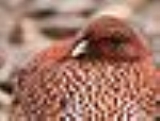
Copper Pheasant
Encyclopedia
The Copper Pheasant, Syrmaticus soemmerringii also known as Soemmerring's Pheasant is a large, up to 136cm long, pheasant
with a rich copper
y chestnut plumage, yellowish bill
, brown iris
and red facial skin. The female is a brown bird with greyish brown upperparts and buff barred dark brown below. The male has short spur on its grey legs, none in female.
 The Copper Pheasant is distributed and endemic
The Copper Pheasant is distributed and endemic
to the hill and mountain forests of Honshū
, Kyūshū
and Shikoku
islands of Japan
, where it is known as . The diet consists mainly of insects, arthropods, roots, leaves and grains.
The scientific name commemorates the German
scientist Samuel Thomas von Sömmering
.
Due to ongoing habitat loss, limited range and overhunting in some areas, the Copper Pheasant is evaluated as Near Threatened on the IUCN Red List
of Threatened Species.
in the early 8th century, as compiled in the Hyakunin Isshu
:
Pheasant
Pheasants refer to some members of the Phasianinae subfamily of Phasianidae in the order Galliformes.Pheasants are characterised by strong sexual dimorphism, males being highly ornate with bright colours and adornments such as wattles and long tails. Males are usually larger than females and have...
with a rich copper
Copper
Copper is a chemical element with the symbol Cu and atomic number 29. It is a ductile metal with very high thermal and electrical conductivity. Pure copper is soft and malleable; an exposed surface has a reddish-orange tarnish...
y chestnut plumage, yellowish bill
Beak
The beak, bill or rostrum is an external anatomical structure of birds which is used for eating and for grooming, manipulating objects, killing prey, fighting, probing for food, courtship and feeding young...
, brown iris
Iris (anatomy)
The iris is a thin, circular structure in the eye, responsible for controlling the diameter and size of the pupils and thus the amount of light reaching the retina. "Eye color" is the color of the iris, which can be green, blue, or brown. In some cases it can be hazel , grey, violet, or even pink...
and red facial skin. The female is a brown bird with greyish brown upperparts and buff barred dark brown below. The male has short spur on its grey legs, none in female.

Endemism in birds
An endemic bird area is a region of the world that contains two or more restricted-range species, while a "secondary area" contains one or more restricted-range species. Both terms were devised by Birdlife International....
to the hill and mountain forests of Honshū
Honshu
is the largest island of Japan. The nation's main island, it is south of Hokkaido across the Tsugaru Strait, north of Shikoku across the Inland Sea, and northeast of Kyushu across the Kanmon Strait...
, Kyūshū
Kyushu
is the third largest island of Japan and most southwesterly of its four main islands. Its alternate ancient names include , , and . The historical regional name is referred to Kyushu and its surrounding islands....
and Shikoku
Shikoku
is the smallest and least populous of the four main islands of Japan, located south of Honshū and east of the island of Kyūshū. Its ancient names include Iyo-no-futana-shima , Iyo-shima , and Futana-shima...
islands of Japan
Japan
Japan is an island nation in East Asia. Located in the Pacific Ocean, it lies to the east of the Sea of Japan, China, North Korea, South Korea and Russia, stretching from the Sea of Okhotsk in the north to the East China Sea and Taiwan in the south...
, where it is known as . The diet consists mainly of insects, arthropods, roots, leaves and grains.
The scientific name commemorates the German
Germany
Germany , officially the Federal Republic of Germany , is a federal parliamentary republic in Europe. The country consists of 16 states while the capital and largest city is Berlin. Germany covers an area of 357,021 km2 and has a largely temperate seasonal climate...
scientist Samuel Thomas von Sömmering
Samuel Thomas von Sömmering
Samuel Thomas von Sömmerring was a German physician, anatomist, anthropologist, paleontologist and inventor. Sömmerring discovered the macula in the retina of the human eye...
.
Due to ongoing habitat loss, limited range and overhunting in some areas, the Copper Pheasant is evaluated as Near Threatened on the IUCN Red List
IUCN Red List
The IUCN Red List of Threatened Species , founded in 1963, is the world's most comprehensive inventory of the global conservation status of biological species. The International Union for Conservation of Nature is the world's main authority on the conservation status of species...
of Threatened Species.
Cultural References
The Copper Pheasant appears in Japanese poetry as far back as poetry composed by Kakinomoto no HitomaroKakinomoto no Hitomaro
Kakinomoto no Hitomaro was a Japanese poet and aristocrat of the late Asuka period. He was the most prominent of the poets included in the Man'yōshū, and was particularly represented in volumes 1 and 2. In Japan, he is considered one of the Thirty-six Poetry Immortals...
in the early 8th century, as compiled in the Hyakunin Isshu
Hyakunin Isshu
is a traditional anthology style of compiling Japanese waka poetry where each contributor writes one poem for the anthology. Literally, it translates to "one hundred people, one poem [each]"...
:

